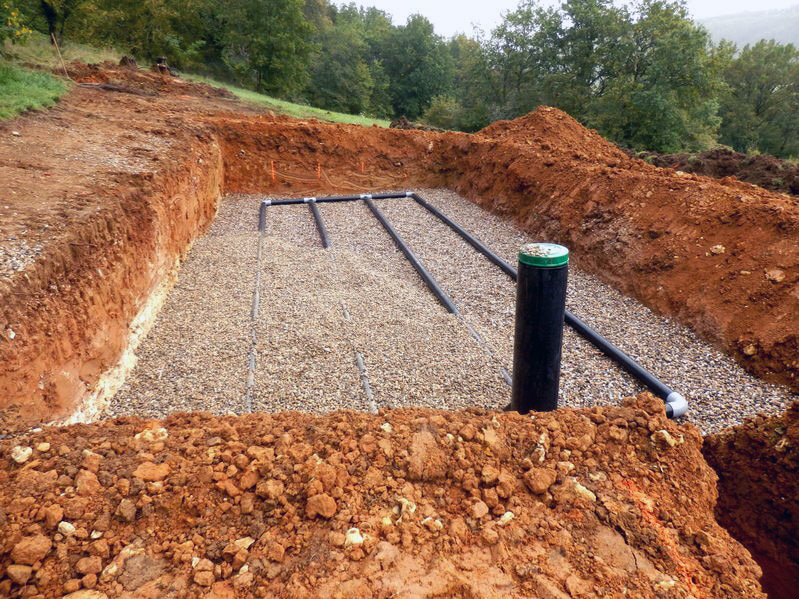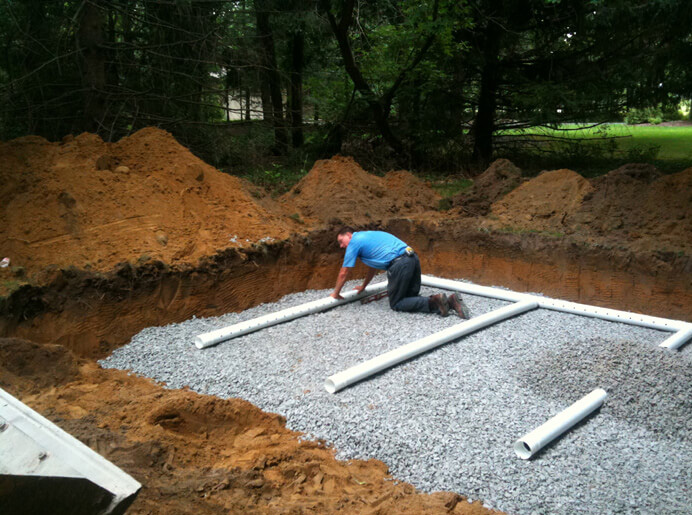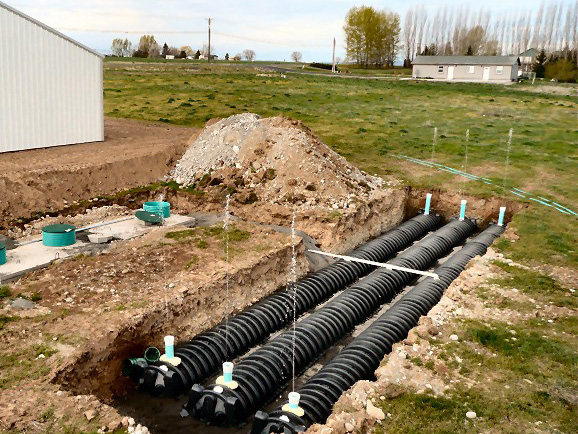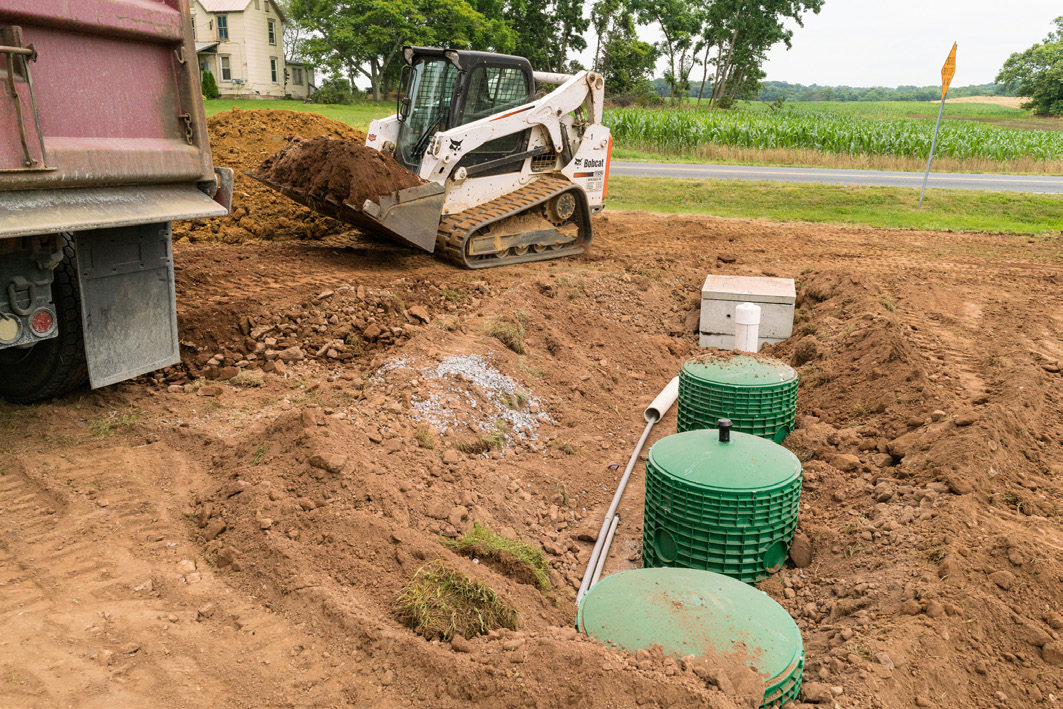IMPROVE YOUR SEPTIC SYSTEM
| In most of Puerto Rico, urban area homes are connected to a main sewer line owned and operated by the Puerto Rico Aqueduct and Sewer Authority (PRASA) that collects and treats household wastewater. Septic design is regulated by the 2018 International Building Code (IBC). On-site septic systems are a suitable form of wastewater treatment in rural and suburban areas where there is space to build them, where the site conditions are considered (including soil type and terrain), and where connections to the central system are not feasible or cost-effective. This strategy explains the basic components of a septic system, the design considerations for each part of the system, and an overview of how to build each part. | Strategy in Action 1. Identify Soil Type and Properties 2. Choose and Plant Vegetation 3. Implement Resilient Site scaping |
WHAT YOU NEED TO KNOW
- A septic system is a mechanism for sewage to exit the home, be stored temporarily, and go back to the soil to inject nutrients and kill bacteria. Every step of the process should be considered as a treatment mode, with particular attention to leach field of design and maintenance such as ensuring adequate plants are used for nutrient uptake, that no heavy weights are placed on the field, and soil has the appropriate absorption and saturation capacity.
- Damaged septic systems can contaminate nearby water bodies and aquifers, leading to diseases that affect your home and community.
- Consult with a professional before installing a system and ensure that the local municipal health department allows it and provides you with all the necessary regulatory input.
- Septic systems fail because:
- Old age, low or lack of maintenance, overloading the septic system above the design limitations, and poor soil conditions or damage to drainfield.
- Septic tanks, particularly concrete or precast, are susceptible to leaks and cracks in landslides and seismic events if built without taking precautionary measures.
- Drainfields can be damaged if heavy weight is placed over the lines or the field is flooded and lacks saturation capacity.
- Solids from the septic system clog the small holes in the drainfield pipes.
- Flushing fats, oils, greases, chemicals, solvents, paint, and other improper substances down the drain that can kill the bacteria that treat waste in the tank and in the drainfield.
- Improperly positioned drainfield in a floodable area of the site.
- They are overloaded by adding too much waste. This can happen in the case of garbage disposal use or adding additional occupants that exceed the system’s design limitations.
- Tree roots uplift drainfield lines.
 |  |  |
 |  |  |
Review Your Home Water Use and Create Water Efficiency and Conservation. Do this where possible. The less wastewater you produce or consider “effluent,” the less water will need to be disposed and treated. See Strategy 19 for reducing your water consumption.

A septic tank is a container comprised of two chambers that separate solid from liquid waste. The solids stay in the tank until they are pumped out by a septic company, and the liquids drain into a leach field or dry well that injects them safely into the soil. Place the tank underground. Do not locate it in a high-water table since this could cause the tank to float.
 | SEPTIC TANK CAPACITY FOR ONE AND TWO FAMILY DWELLINGS
|
SIZE
- The size of the septic tank depends on the number of people, and the amount of waste producer per person each day.
- Install a larger tank if you envision your home expanding.
- Larger tanks need to be emptied fewer times than a smaller tank.
- Follow guidelines from the local municipality, the Health Department, and the Junta de Calidad Ambiental.
- Work with a professional on designing and installing the tank, as it can become a health hazard for your home and community.
- Consider adding a septic effluent filter to the septic tank to catch suspended solids, smaller particles of debris which, as they pass out to the soil absorption system, or drainfield, which can create clogging of the drainfield lines and reduce absorption and treatment.
- Alarm septic tanks to warn of an operating problem with the system that could risk a sewage backup into the building.
OPERATIONS
- Hire specialized companies to pump out solids that may clog the small holes in the each field pipes.
- Never use bleach in tank.
- Check alarm systems regularly.
- Check regularly for any cracks or leaks, especially after a natural disaster.
- If the tank requires constant pumping or experiences continuous backups and overflows, it may be failing.
- Place a septic waste water filter in the tank to filter large particles from entering the leach field and clogging the system.
- Do not throw fats, oils, greases, chemicals, solvents, paint, and other substances down the drain. These may clog the system, kill the bacteria that treat waste in the tank, or contaminate the environment around the leach field.
- Use lightweight, septic-system safe toilet paper and do not flush bulky cotton items like paper towels or hygiene products.
REGULATORY AND CODE
- The 2018 IPSDC (International Private Sewage Disposal Code) provides tables with the minimum sizes for the septic tanks, pumping chambers and holding tanks, based on the number of bedrooms for one and two-family dwellings, and per bedroom for Apartment buildings and condominiums.
- 2018 International Private Sewage Disposal Code
- Regulations as established by Environmental Quality Board.
MATERIAL

PLASTIC
- Last longer, less maintenance required
- Higher cost

CONCRETE
- Can be custom built
- Inexpensive
- Gets damaged more easily
OPERATIONS AND MAINTENANCE TIPS
- Document your system
- Document every component of the septic system and keep these organized as a set of “as-builts” for current and future operations. Take photos of:
- Septic tank location
- Leach field layout or location of dry well
- Layout of the drain field lines and the position of your tank in regards to the house plumbing
- Layout of the drain field in regards to plantings
- Electrical components
- Reduce putting any loads on leach field such as parking or heavy objects which can disrupt lines and compact soil preventing treatment from occurring.
- Don’t place bleach or chlorine down the drains because it can destroy critical bacteria colonies that treat wastewater in your septic tank.
- If possible, drain your septic system before any major climatic event. A good rule of thumb is to drain it around August, right before hurricane season is at its peak.
- Septic Tanks
- Hire specialized companies to pump out solids.
- Never use bleach in the tank.
- Check that alarm systems are in working order.
- Leach Field
- Maintain soil porosity and ensure that no significant weight is placed on the drainfield, such as parking or structures.
- Ensure lines are properly buried and unclogged.
- Keep an eye out for the following signs of septic
- Wastewater backing up into household drains.
- Bright green, spongy grass on the drainfield, especially during dry weather.
- Pooling water or muddy soil around your septic system or in your basement.
- A strong odor around the septic tank and drainfield.
- If the drainfield is overloaded with too much liquid, it can flood, causing sewage to flow to the ground surface or create backups in toilets and sinks.
- Septic tanks that require constant pumping or that experience continual backups and overflows during normal use may be in the first stages of septic system failure.
A leach field or drainfield is the final stage of the septic system and provides additional treatment of wastewater. A drainfield is arrangement of perforated pipes over a series of trenches on site filled with appropriate soil, sand or gravel. The liquid wastewater in the septic tank exits by gravity or pumps into the leach field and percolates into the soil, naturally injecting nutrients and removing harmful bacteria.
Using drain field is a best practice management for onsite treatment systems. The liquid wastewater in the septic tank exits by gravity or pumps into the leach field and percolates into the soil, naturally injecting nutrients and removing harmful bacteria.
 |  |
 |  |

SIZE
- The size of the leachfield needed can range depending on the number of bedrooms, soil percolation rate, depth of field and composition of soil and use of aggregate like gravel .
OPERATIONS
- Maintain soil porosity and ensure no weight is placed on the leach field, like parking or structures.
- Ensure lines are properly buried and unclogged.
- Keep an eye out for:
- Bright, green, spongy grass on the leach field, especially during dry weather
- Pooling water or muddy soil around the system. If the leach field is overloaded it can cause sewage to flow to the ground, surface or create backups in plumbing fixtures.
- A strong odor around the septic tank or leach field
SITE
- Place far away from habitational areas.
- Identify which soil is appropriate for the land plot.
- The soil percolation rate is a measurement of how much water a type of soil can absorb in a particular amount of time. It is recommended that the soil neither retain water nor let it pass through too quickly. Sandy loamy soil or sand have good draining capacity.
- Consult a soil engineer for a thorough percolation test and comprehensive soil analysis.
- Soil on top of the tank must be sloped downwards to allow surface water to flow away from the system.
- Set aside an area the same size as the primary drainfield for use as a replacement drainfield if something happens to the primary one.
- Consult with the Puerto Rico Office of General Permit (OGPe) guidance on construction requirements and minimal distance from athe water body.
FIELDWORK
- Fence off or mark up the leach field to alert of its location.
- Cover the whole system with a layer of topsoil to prevent animals and surface runoff from reaching wastewater.
VEGETATION
- Plant vegetation and locate mounds of soil around the leach field so it absorbs excess water and nutrients from the septic tank.
- Choose a native plant species with a shallow root system that can uptake water and nutrients from effluent but will not clog the drain pipes.
- Do not plant trees or shrubs within 25 feet
SITE AND BUILD A DRY WELL
 Use in zones with inadequate soil absorption capabilities, limited space, or steep slopes.
Use in zones with inadequate soil absorption capabilities, limited space, or steep slopes.- A dry well is a type of leaching mechanism which is an alternative to a traditional leachfield when conditions don’t permit. It consists of a bottomless tank with holes on the side, and uses stone or aggregate material to control the injection process into the soil.
- Add gravel around it at the bottom of the well so wastewater percolates into the soil while solids will remain in place for later disposal.
- Add gravel around it at the bottom of the well so wastewater percolates into the soil while solids will remain in place for later disposal.
- A dry well utilizes gravel and other permeable materials to slow the injection process into the surrounding earth. It is an alternative to traditional leaching systems on lands with inadequate soil absorption capabilities.

 Use in zones with inadequate soil absorption capabilities, limited space, or steep slopes.
Use in zones with inadequate soil absorption capabilities, limited space, or steep slopes.